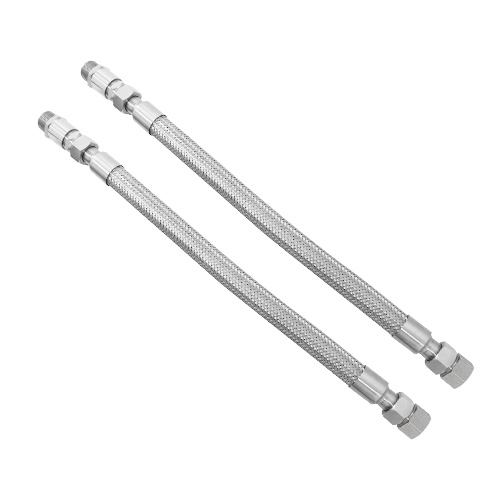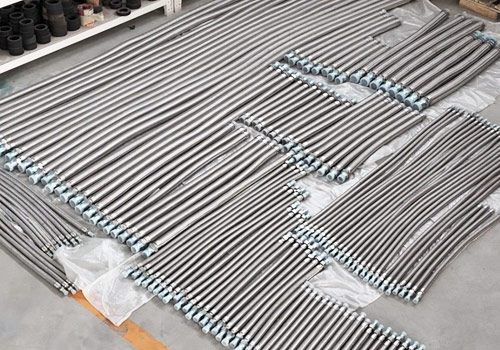-
هاتف: +86-13581108878
-
بريد إلكتروني: [email protected]
جدول المحتويات
مقدمة

In modern industrial settings, efficiently transferring diverse media is crucial. Rigid piping often falls short in dynamic environments or where vibration dampening is needed. This is where flex metal tubing excels, offering a versatile and resilient solution for fluid transfer challenges.
Known as flexible metal hose, flex metal tubing is vital across industries like petrochemical, aerospace, and food processing. Its unique design allows for significant movement, making it perfect for applications involving thermal expansion, vibration, or constant repositioning. Understanding its benefits is key to optimizing your operations for safety, longevity, and cost-effectiveness.
At الختم الحديث, a leading manufacturer of high-quality dynamic and static sealing solutions, we possess deep expertise in flex metal tubing. With extensive experience and patented technologies in this field, we help clients make informed decisions for their fluid transfer needs. This blog post will highlight five essential benefits of flex metal tubing crucial for industrial professionals.
Understanding Flex Metal Tubing: Beyond the Basics
Before diving into its specific benefits, it’s helpful to grasp what flex metal tubing truly is and how it differs from other flexible hose options. Unlike rubber or plastic hoses, flex metal tubing is constructed from stainless steel or other high-grade alloys, which are then formed into a corrugated pattern. This corrugation is the key to its flexibility, allowing it to bend, compress, and extend while maintaining its structural integrity and pressure containment capabilities.
1. Exceptional Pressure and Temperature Resistance
One of the foremost advantages of flex metal tubing is its superior ability to withstand extreme pressures and temperatures. Unlike non-metallic hoses, which can degrade or rupture under high thermal and pressure loads, metal tubing retains its strength and integrity across a vast range.
- High Pressure Capability: The metallic construction, especially when reinforced with external braiding, allows flex metal tubing to handle very high operating pressures, often exceeding what rubber or plastic hoses can safely manage. This makes it indispensable in hydraulic systems, steam lines, and high-pressure gas transfer applications where safety and reliability are paramount. The inherent strength of the metal provides a reliable barrier against blowouts.
- Extreme Temperature Tolerance: Whether it’s superheated steam, cryogenic liquids, or high-temperature exhaust gases, flex metal tubing can operate effectively in environments ranging from sub-zero cryogenic temperatures to several hundred degrees Celsius. This broad temperature range is unmatched by most other flexible materials, preventing material degradation, embrittlement, or softening that could lead to system failure. This makes it a go-to solution for applications in power generation, chemical processing, and industrial furnaces.
2. Superior Chemical Compatibility
Another critical benefit that sets flex metal tubing apart is its remarkable chemical compatibility. The choice of material, typically stainless steel (like 304, 316, or 321), makes it highly resistant to corrosion and degradation from a wide array of aggressive chemicals, acids, alkalis, and solvents.
- Corrosion Resistance: In industries such as chemical processing, pharmaceuticals, and food and beverage, hoses frequently come into contact with corrosive substances that can quickly break down rubber or plastic. Flex metal tubing, especially those made from specific stainless steel grades, offers excellent resistance to chemical attack, ensuring the purity of the transferred media and the longevity of the hose. This reduces the risk of contamination and prolongs the service life of the assembly.
- Versatility Across Media: This high chemical resistance means a single type of flex metal tubing can often be used for multiple media types within a facility, simplifying inventory and reducing the chances of using an incompatible hose. This versatility is invaluable in complex industrial setups where different chemicals might be routed through similar pathways.
3. Excellent Flexibility and Vibration Absorption

Despite being made of metal, flex metal tubing is specifically designed to offer remarkable flexibility, which is crucial for dynamic applications and mitigating equipment wear.
- Accommodating Misalignment and Movement: In many industrial setups, perfect alignment between components is challenging to achieve or maintain. Flex metal tubing can easily compensate for minor static or dynamic misalignments, reducing stress on connecting equipment. It’s also vital for applications with constant motion, such as robotics or moving machinery parts, where a rigid connection would quickly fail due to fatigue.
- Vibration Dampening: Equipment vibration is a common issue in industrial environments, leading to noise, fatigue, and premature failure of rigid components. Flex metal tubing acts as a natural dampener, absorbing and isolating vibrations transmitted from pumps, compressors, and engines. This not only extends the life of adjacent equipment but also contributes to a quieter and safer working environment. The inherent corrugations of the flex metal tubing allow it to absorb these kinetic energies effectively.
4. Enhanced Durability and Longevity
The robust construction of flex metal tubing translates directly into exceptional durability and a longer service life compared to many alternative hose materials.
- Resistance to Abrasions and Punctures: Unlike non-metallic hoses that can be easily cut, abraded, or punctured by external forces or abrasive media, flex metal tubing offers inherent resistance to such damage. This makes it ideal for harsh industrial environments where physical integrity is constantly challenged, reducing the frequency of replacements and associated downtime.
- Fatigue Resistance: While all materials are subject to fatigue, the engineered design of corrugated metal hose, often coupled with braiding, provides excellent resistance to flex fatigue. This means it can withstand repeated bending and flexing cycles without developing cracks or leaks, ensuring reliability in applications with continuous movement.
- Fire Safety: In critical applications where fire hazards exist, flex metal tubing offers a significant safety advantage. Being non-combustible, it will not contribute to the spread of fire and can maintain its integrity long enough for emergency procedures, unlike plastic or rubber hoses that can melt or burn.
5. Versatility in Applications and Customization
The combined benefits of pressure, temperature, chemical resistance, flexibility, and durability make flex metal tubing incredibly versatile, finding applications across almost every industrial sector.
- Broad Range of Uses: From conveying corrosive chemicals and high-pressure gases to acting as exhaust connectors or vacuum lines, the adaptability of flex metal tubing is astounding. It is used in automotive, aerospace, power generation, oil and gas, food processing, and many other industries.
- Customization Potential: Flex metal tubing can be custom-fabricated to meet specific application requirements regarding length, diameter, end fittings, and material grades. This ensures a perfect fit and optimal performance for unique challenges, from specific bending radii to specialized connection types. This level of customization ensures that the flex metal tubing perfectly integrates into existing systems.
Understanding Flex Metal Tubing Applications and Characteristics
| Feature | وصف | Key Application Area Examples | Benefits for System Design |
| Material | Stainless Steel (304, 316, 321), Bronze, Inconel etc. | Chemical processing, Cryogenics, High-temp exhaust | High corrosion resistance, wide temperature range |
| تصنيف الضغط | Varies significantly based on diameter & braiding | Hydraulic systems, High-pressure gas transfer | Enhanced safety, reliable fluid containment |
| نطاق درجة الحرارة | Typically -200°C to +700°C (material dependent) | Steam lines, Furnaces, LNG transfer | Prevents material degradation in extreme conditions |
| Flexibility | Achieved through corrugations (annular/helical) | Vibration dampening, Misalignment compensation, Robotics | Reduces stress on equipment, extends component life |
| End Fittings | Weld nipples, flanges, quick disconnects, threaded | Custom integration into any piping system | Leak-tight connections, ease of installation & removal |
| Braiding | Single or multi-layer wire braid | Increases pressure resistance, prevents elongation | Adds strength and durability for demanding applications |
خاتمة
The advantages of flex metal tubing go far beyond simple fluid transfer. Its unmatched resistance to extreme pressures and temperatures, superior chemical compatibility, inherent flexibility, vibration absorption, and exceptional durability make it vital for demanding industrial uses. Investing in high-quality flex metal hoses is a smart move that boosts safety, cuts maintenance costs, and improves long-term operational efficiency.
At Modern Sealing, we’re proud to provide flex metal tubing solutions backed by our extensive experience and patented dynamic and static sealing technologies. Our dedication to quality ensures reliable, high-performance products designed for your needs. If you want to optimize your fluid transfer systems with robust and versatile flex metal tubing, contact us today to see how our expertise can help your operations.
التعليمات
What is the primary difference between flex metal tubing and rubber hoses?
The primary difference lies in their material composition and resulting properties. Flex metal tubing is made from metallic alloys like stainless steel, offering superior resistance to extreme temperatures, high pressures, and corrosive chemicals. Rubber hoses are made from elastomers and are generally more flexible at lower temperatures and pressures but degrade under harsh conditions where flex metal hoses excels.
Can flex metal tubing be used for both liquid and gas transfer?
Yes, flex metal tubing is highly versatile and can be used for transferring a wide range of media, including both liquids and gases. Its robust construction ensures leak-tight containment for high-pressure gases and prevents degradation from various liquids, including aggressive chemicals.
How is the flexibility of flex metal tubing achieved?
The flexibility of flex metal hoses is primarily achieved through its corrugated structure. The corrugations (either annular or helical) allow the metal to bend, flex, and extend without compromising the integrity of the material or the containment of the media. This engineered design is key to its dynamic capabilities.
Is flex metal tubing resistant to corrosion?
Yes, flex metal tubing is highly resistant to corrosion, especially when manufactured from stainless steel grades like 304, 316, or 321. These materials are specifically chosen for their ability to withstand aggressive chemicals, acids, and alkalis, making flex metal hoses suitable for corrosive environments where other materials would quickly fail.


